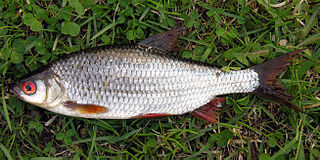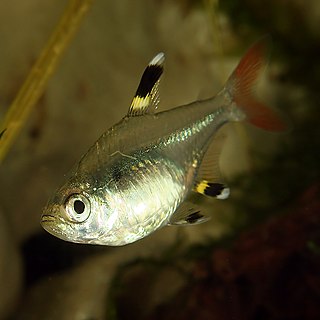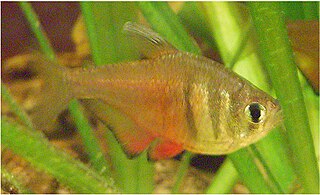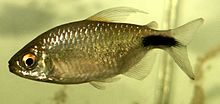
The neon tetra is a vibrant freshwater fish from the Amazon basin, renowned for its bright blue and red stripes, making it a favorite among aquarium hobbyists. In the wild, it inhabits warm, acidic waters in blackwater and clearwater streams, avoiding whitewater rivers. Distinguished by its iridescent coloration, which changes with light conditions, the neon tetra exhibits slight sexual dimorphism in its body shape and stripe curvature. First described in 1936, it is now a staple in the aquarium trade, primarily farm-raised in Southeast Asia. Neon tetras require specific water conditions and thrive in groups within well-planted tanks. They have an omnivorous diet, including small aquatic foods. Breeding in captivity is challenging and they are prone to neon tetra disease, an often fatal condition. Proper care and preventive measures are crucial for their health in aquariums.

Tetra is the common name of many small freshwater characiform fishes. Tetras come from Africa, Central America, and South America, belonging to the biological family Characidae and to its former subfamilies Alestidae and Lebiasinidae. The Characidae are distinguished from other fish by the presence of a small adipose fin between the dorsal and caudal fins. Many of these, such as the neon tetra, are brightly colored and easy to keep in captivity. Consequently, they are extremely popular for home aquaria.

The Congo tetra is a species of fish in the African tetra family, found in the central Congo River Basin in Africa. It is commonly kept in aquaria.

The roach, or rutilus roach, also known as the common roach, is a fresh- and brackish-water fish of the family Cyprinidae, native to most of Europe and western Asia. Fish called roach can be any species of the genera Rutilus and Hesperoleucus, depending on locality. The plural of the term is also roach.

The big-scale pomfret also known as the long-finned bream, is a species of marine ray-finned fish, a pomfret of the family Bramidae. It is found in the Atlantic ocean, at depths down to 500 metres (1,600 ft). This species reaches a length of up to 100 centimetres (39 in) SL. This species is of minor importance to the commercial fisheries industry. From Ireland there are only two records of this fish. The last being from Co. Wicklow.

The lemon tetra is a species of tropical freshwater fish which originates from South America, belonging to the family Characidae. It is a small tetra growing to 5 cm in length. The species is a long established favourite aquarium fish, being introduced to the aquarium in 1932.

The rummy-nose tetra is a species of tropical freshwater characin fish originating in South America, popular among fishkeepers as a tropical aquarium fish. One of many small tetras belonging to the same genus, it is on average 5 cm (2 in) long when fully grown. The fish is one of several very similar species including Hemigrammus bleheri, and Petitella georgiae, and it is possible that more recently collected specimens available in the aquarium trade are members of one or other of these similar species. The common name applied to most of these fishes is "rummy-nose tetra", though other common names are in circulation.

Pelvicachromis pulcher is a freshwater fish of the cichlid family, endemic to Nigeria and Cameroon. It is popular amongst aquarium hobbyists, and is most commonly sold under the name kribensis, although it has other common names, including various derivatives and color morphs of the kribensis: krib, common krib, red krib, super-red krib and rainbow krib, along with rainbow cichlid and purple cichlid.

Pristella maxillaris is a species of characin in the genus Pristella, and is commonly known as the X-ray fish or X-ray tetra because of its translucent body. It is a widely distributed and adaptable fish, found in the Amazon and Orinoco basins, as well as coastal rivers in the Guianas in both acidic and alkaline waters. Unlike most other characins, it is tolerant of slightly brackish water. It is small and lives in large groups, and males can be distinguished from females by being smaller and thinner than the females. Like most other tetras, it feeds primarily on small insects and planktonic animals.

The diamond tetra is a small freshwater fish of the characin family of order Characiformes. It is found in and around Lake Valencia in Venezuela, South America.

The flame tetra, also known as the red tetra or Rio tetra, is a small freshwater fish of the characin family Characidae. This tetra was first introduced as aquarium fish in 1920 by C. Bruening, Hamburg, Germany, and formally described in 1924 by Dr. George S. Myers. Today large numbers are bred in captivity and it is common in the aquarium trade, but the remaining wild population in Southeast Brazil is highly threatened.
Trichogenes longipinnis, is a species of catfish of the family Trichomycteridae. T. longipinnis is endemic to coastal streams in the Atlantic forest between Rio de Janeiro and São Paulo States in southeastern Brazil.

Brycinus is a genus of ray-finned fish in the family Alestiidae. Like other "African characids", they were formerly included in the Characidae but are actually somewhat more distantly related Characiformes.

The European flounder is a flatfish of European coastal waters from the White Sea in the north to the Mediterranean and the Black Sea in the south. It has been introduced into the United States and Canada accidentally through transport in ballast water. It is caught and used for human consumption.

The violet goby is a species of goby native to marine, fresh and brackish waters near the Atlantic coast of North and South America from South Carolina in the United States of America, to northern Brazil. It prefers bays, estuaries and river mouths with muddy substrates. It is often marketed as the dragon goby or dragon fish.

Nematobrycon palmeri, commonly known as the emperor tetra, is a species of characid fish found in the Atrato and San Juan river basins in western Colombia. It was first imported in the aquarium trade to the United States in 1960 and has since become well established.

Coastal fish, also called inshore fish or neritic fish, inhabit the sea between the shoreline and the edge of the continental shelf. Since the continental shelf is usually less than 200 metres (660 ft) deep, it follows that pelagic coastal fish are generally epipelagic fish, inhabiting the sunlit epipelagic zone. Coastal fish can be contrasted with oceanic fish or offshore fish, which inhabit the deep seas beyond the continental shelves.

The yellow-tailed African tetra is a freshwater fish that lives in the Congo River basin. It is found in both the Democratic Republic of the Congo and the Republic of the Congo. It is an omnivore in the wild which feeds on crustaceans, fallen fruits and small insects, but seems to have little difficulty in adjusting to normal aquarium foods. though they can be fed in aquarium with daphnia, bloostorm and artemia along good quality dried flakes and granules at least some of which should include additional plant or algal content. The species can tolerate water up to 20 degrees DH, though it does better in softer water. A temperature of 22–26 °C (72–79 °F) and a pH of between 5.0 and 7.5 and a hardness of between 36 and 268ppm is suitable. adult male are more colorful and tend to grow faster than females. males also develops extended white-tipped dorsal, ventral, caudal and anal fins which females lack. it is an egg scattered exhibiting no parental care, and one method of breeding is apparently to keep a group of adults in their own aquarium furnished with a kind of artificial trap, checking it regularly as much as possible especially for eggs. these are removed and normally hatched in smaller containers with the fry being offered microscopic foods until large enough to accept daphnia, bloostorm and the rest.

Eels are elongated fish, ranging in length from five centimetres (2 in) to four metres (13 ft). Adults range in weight from 30 grams to over 25 kilograms. They possess no pelvic fins, and many species also lack pectoral fins. The dorsal and anal fins are fused with the caudal or tail fin, forming a single ribbon running along much of the length of the animal. Most eels live in the shallow waters of the ocean and burrow into sand, mud, or amongst rocks. A majority of eel species are nocturnal and thus are rarely seen. Sometimes, they are seen living together in holes, or "eel pits". Some species of eels live in deeper water on the continental shelves and over the slopes deep as 4,000 metres (13,000 ft). Only members of the family Anguillidae regularly inhabit fresh water, but they too return to the sea to breed.

The white sucker is a species of freshwater cypriniform fish inhabiting the upper Midwest and Northeast in North America, but it is also found as far south as Georgia and as far west as New Mexico. The fish is commonly known as a "sucker" due to its fleshy, papillose lips that suck up organic matter and aufwuchs from the bottom of rivers and streams.




















